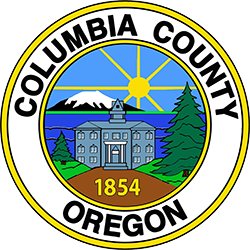Study Results
Phase 1 Summary
Vantage Point Solutions (VPS) collected data directly from each Provider’s site, as well as from multiple publicly available sources including BroadbandNow.com, Business.org, and Reviews.org. The data originated from information self-reported by the carriers to third party sites and is generally based on availability in an area rather than by individual addresses. As such, the data will not have pinpoint accuracy and should be used only as an overview.
At the time of data collection, Comcast was still implementing service to Rainier (97048), and would now be noted as a provider offering 25Mbps in that Zip Code. Limited data was available for Cascade Networks/Wave, which currently provides service to portions of 97016.
Overall, the self-reported data shows significant broadband coverage gaps, particularly in the 97016, 97054, and 97056 areas.

Phase 2 Summary
This second phase of the study primarily focused on conducting County, community and stakeholder outreach. Stakeholders represent key groups of potential end-users of a municipal network such as citizens, businesses and government agencies. The purpose of the outreach is to obtain feedback regarding current levels of service, future needs and concerns.
The primary outreach tools were a randomly selected household survey and an online business survey. Additional input was gained through a series of stakeholder group meetings, individual interviews, an informal online survey, and two town hall events.
Household Survey
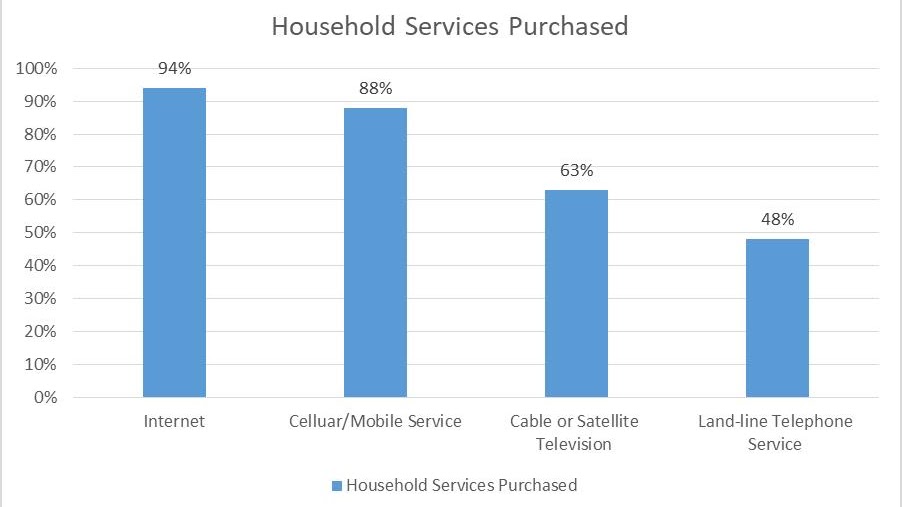 | 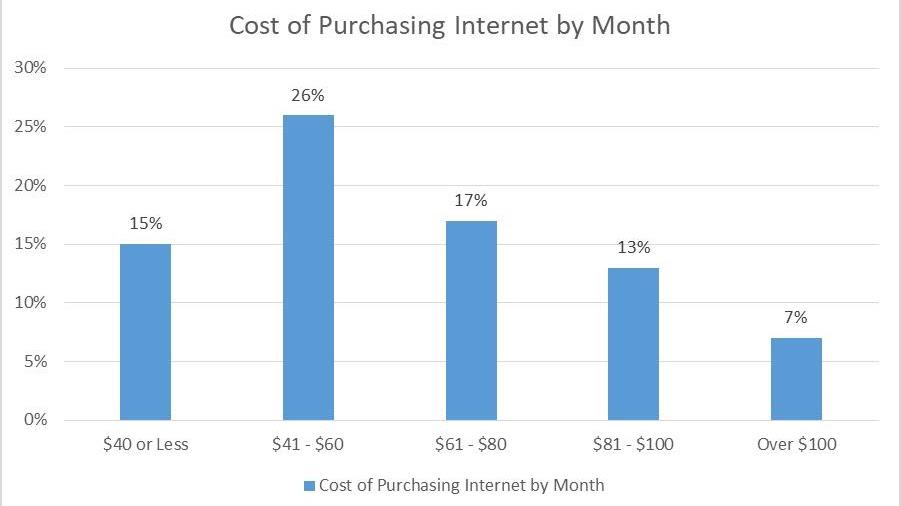 | |
Approximately 95% of respondents purchase internet services in some form in Columbia County. Almost 50% of those who do not purchase internet services indicated that internet was not available at their location. Other reasons for not purchasing internet included that an internet connection was too expensive (22%), or their family had no need for internet (9%). Just over 4% indicated that internet was simply too slow to purchase. | Around 22% of respondents answered that they purchase internet through a bundled package with phone and/or television so it’s difficult to determine how much they are paying just for internet. It is important to note that 38% of respondents receive their service from Comcast. Just over 36% purchase service from Century Link with less than 14% purchasing internet services from Frontier Communications. The remaining 11% is made up of various providers with Hughes Net (4%) as the next most used provider. Many respondents commented that they did not feel they had enough options in their respective areas. | |
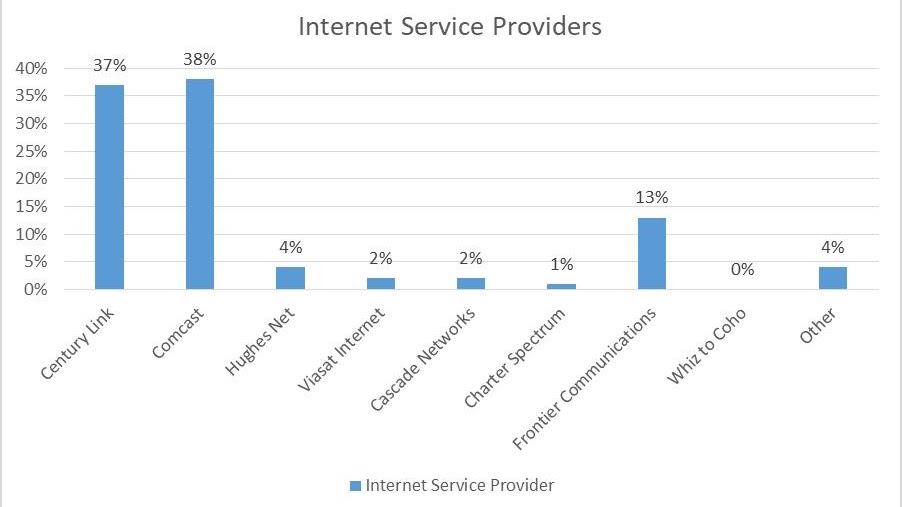 | 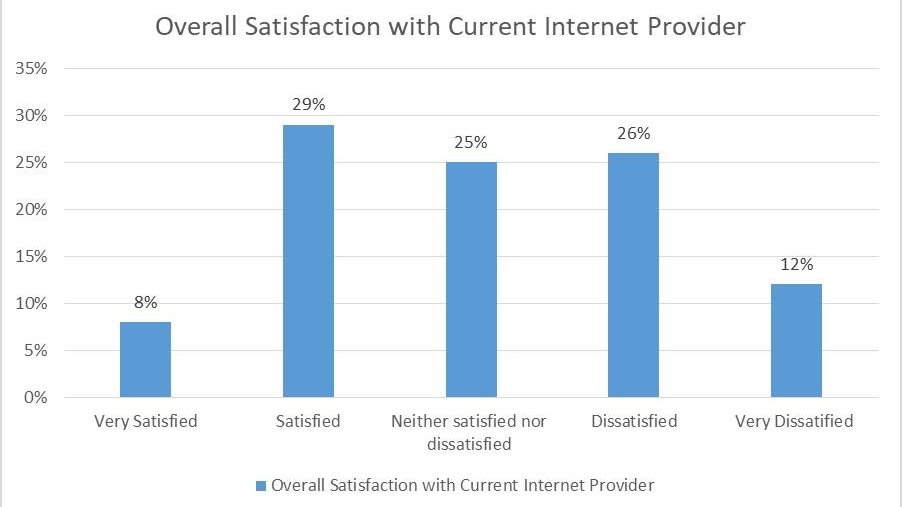 | |
*Note that these numbers are rounded to the nearest whole number. Charter Spectrum is the exception with only .22% in actuality. | *Note that these numbers are rounded to the nearest whole number Approximately 38% of respondents are either very satisfied or satisfied with their current provider and approximately 38% of respondents saying they are dissatisfied or very dissatisfied with the current service as a whole from their internet provider. This leaves 25% who are neither satisfied nor dissatisfied. This level of satisfaction is well below average for what is typical. |
Business Survey
As of the writing of the Report, the informal business survey had only collected 7 responses. As a result, the survey will be left open and VPS will work with the County to find better ways to promote the business survey. However, below we have provided a few pieces of information that give a sense of what businesses are experiencing in Columbia County.
- Bandwidth varied dramatically between 8mpbs to one gigabit.
- Only one business was satisfied with their current internet, the rest were not sure or worse and 6 out of 7 want to switch providers.
- Comments provided include:
- “Asked Comcast: $66,000 to get service run. Century Link wants a 3 year contract at $2,400/month for fiber.”
- “It should be cheaper, especially if you don’t have a bundle.”
Town Halls
Columbia County, in conjunction with Vantage Point Solutions (VPS) held two citizen town hall meetings in Vernonia and St. Helens. A take away from these meetings were that citizens were frustrated with their current services.
Vernonia Town Hall:
- Frontier is only carrier. Internet service is terrible. There are major issues with reliability.
- The further away from the node you live, the worse your service gets.
- Folks would like to work from home but cannot with such poor service.
- It’s hard to get someone out to fix service.
- Some cannot use Netflix after 4pm
- Cell service is inconsistent.
- Internet is expensive for what is offered.
St. Helens Town Hall
- There are big problems with reliability and consistency throughout the County.
- In Scappoose, Century Link frequently goes out and can barely do anything with current connection.
- In Warren, at one location, the only option is Century Link and can’t get more than 1.5 Mbps.
- Would like to start a home business but only option is satellite and that’s not enough bandwidth to do anything.
- Cell service is inconsistent depending on carrier.
Phase 3 Summary
VPS provided a variety of potential fiber network models, operational types, and funding mechanisms for this phase of the study. Their recommendation for Columbia County was to implement a middle mile* network that provides a redundant ring backbone connected to community anchor institutions and available for lease. They felt a middle-mile network was a good option for Columbia for the following reasons:
- There are already parts of the County that have adequate residential and business service and so a County-wide last-mile network is not needed;
- There is a middle-mile infrastructure problem County-wide in that there is not enough fiber in many areas to support a robust last mile network, cell service or create a redundant network to safeguard against fiber cuts;
- The County has potential opportunities to work with one or more last-mile provider partners to operate the network and increase last-mile services to areas where it is needed. In addition, in Columbia County, any network would need to begin with middle-mile infrastructure to support any future last-mile network builds.
*A Middle-Mile Network is typically defined as a network that serves community anchor institutions (i.e. Schools, libraries, government buildings, public safety agencies, hospitals, etc.) but does not directly serve homes and businesses.
Final Report Recommendations
Based on their data collection and analysis, VPS offered the following 3 recommendations for Columbia County:
Recommendation #1 -
Columbia County should consider building a middle-mile network. This could be done all at once or phased in over time.
Recommendation #2 -
The County should pursue establishing a partnership with a last-mile provider.
Recommendation #3 -
Columbia County should consider establishing a Columbia County Broadband Consortium that can focus on pursuing funding and establishing partnerships for middle-mile and last-mile network deployment.
For the full text of the project reports, see the More Info page.
What’s Next?
General Recommendations from Study
VPS provided the following Strategic Plan outline to help inform next steps in the County's project. The purpose of a Strategic Plan is to focus on setting mid to long-term goals and devise a plan for achieving them.
The Strategic Plan Summary is available in the Final Executive report. It provides additional guidance for the implementation of the three main recommendations, which are:
- The County should create a Broadband Consortium that can focus on pursuing funding and establishing partnerships for middle-mile and last-mile network deployment.
- The County should pursue establishing a partnership with a last-mile provider.
- The County should consider building a middle-mile network that could be implemented all at once or phased in over time.
- The County should research potential grant funding opportunities.
It should be noted that Columbia County should focus on completing steps 1 and 2 first. The County should establish a Consortium before establishing partnerships and both of these steps should happen before a network plan can be truly developed.
Issues and Approved Next Steps
The biggest hurdle the County faces to implementing a fiber project, such as what's recommended, is cost. There is no current, dedicated funding for building a middle-mile network. Additionally, much of the grant funding available comes with specific qualifications, such as population density, that the County may or may not meet. However, this study has established that the need exists, and thus laid the groundwork for future grant application. While the funding is an ongoing challenge, the County is committed to improved broadband access for residents and businesses alike. As such, staff will pursue the establishment of a Broadband Consortium and partnership with a last mile provider, as recommended by VPS. Staff will also look at other tools that could potentially encourage existing service providers to expand their service areas, such as franchising agreements that offer incentives for infrastructure improvements and dig-once policies that give vendors an opportunity to place conduit during road construction projects that expose the right-of-way.
More Info
Links to Broadband Study Documents
Broadband Feasibility Study - Phase 1: Provider Analysis
Broadband Feasibility Study - Phase 2: County and Community Stakeholder Report
Broadband Feasibility Study - Phase 3: Network Models Report
Final Executive Report.pdf (columbiacountyor.gov)
Links to Additional Information on Broadband
Broadband Regulation
Successful Municipal Broadband Programs
- Wasco County, Oregon - http://www.qlife.net/
- Sandy, Oregon - https://www.ci.sandy.or.us/SandyNet/
- Rio Blanco County - https://muninetworks.org/content/rural-rio-blanco-county-builds-open-access-fiber-wireless-community-broadband-bits-podcast
- Kent County, Maryland - http://fiber.kentcounty.com/
Bibliography
FCC. “Types of Broadband Connections.” Federal Communications Commission, 24 June 2014, www.fcc.gov/general/types-broadband-connections.
